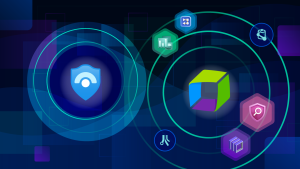With the DevSecOps maturity model as guidance, organizations are better positioned to counteract cyberthreats and software quality risks whether they manifest in development or in live applications.
As organizations adopt DevOps methodologies that integrate security practices, or DevSecOps, standards boards create guidelines, such as the OWASP DevSecOps maturity model. Such standards provide a framework that can help organizations get started on their DevSecOps journeys. But because every organization is unique, and modern multicloud environments are so complex, such standards can also be limiting. Every DevSecOps maturity model has its own special requirements.
But whatever framework you use, there are some common best practices to embrace—and struggles to avoid.
What is DevSecOps and what is a DevSecOps maturity model?
DevSecOps brings development, operations, and security teams together in the software development lifecycle (SDLC). This approach enables teams to focus on speed and agility in software development without compromising security. A DevSecOps approach advances the maturity of DevOps practices by incorporating security considerations into every stage of the process, from development to deployment. There are a few key best practices to keep in mind that formulate the perfect DevSecOps maturity model.
With a robust DevSecOps maturity model, organizations are better positioned to counteract cyber threats and software quality risks whether they manifest in development or in live applications. A strong DevSecOps maturity model helps organizations “shift left” to address software risks in development and “shift right” with problems in production.
What are the best practices that form the DevSecOps maturity model?
DevSecOps best practices provide guidelines to help organizations achieve efficient and secure application design, development, implementation, and management. The ability of organizations to effectively implement these best practices throughout the entire SDLC is known as DevSecOps maturity.
Some DevSecOps best practices include the following:
- Security by design. DevSecOps practices build on DevOps, ensuring that security concerns are top of mind as developers build code. Integrating security into every step of the software development lifecycle can help organizations improve their overall application security, so they can better protect against cyber-attacks and minimize software quality risks.
- Release validation. Answer-driven release validation transforms security from a detached, often manual process to an automated release process that provides continuous feedback to the DevSecOps team. Introducing release validations into your continuous delivery pipeline allows for automated analysis of the quality of your new software versions and planned releases. These checks not only automatically detect vulnerabilities; they also automatically assess risk and user impact thereby avoiding false positives and helping teams to focus on what matters most.
- The education of employees about security awareness. Organizations should train DevOps teams to understand security best practices and how to operate any new tooling implementations. Developers need to be aware of any third-party libraries they’re utilizing, and possible security concerns that can occur. Teams must truly take responsibility for software security, just as much responsibility as they take for features, function, and usability.
DevSecOps best practices help align DevOps and security efforts by making security part of the conversation at every stage of application development and management. Incorporating security reduces the risk of post-deployment security issues and provides increased visibility into potential challenges as they emerge.
The DevSecOps maturity industry standard
As DevSecOps methodology becomes more pervasive within organizations and industries, there is a push to create more universally adopted maturity industry standards. While there is no required standard for DevSecOps maturity, most frameworks enlist a multistage approach that provides a pathway to success.
The OWASP DevSecOps maturity model divides maturity into four levels, each with its own approach to operations. Level 1 is the basic understanding of security practices, level 2 is the adoption of basic security practices, level 3 is the high adoption of security practices, and level 4 is the advanced deployment of security practices at scale. Although this is a good model to start with, it misses key aspects such as monitoring, observability, and release validation – all of which are very important in DevSecOps.
Why organizations struggle to implement DevSecOps best practices
Despite the benefits of DevSecOps best practices, many companies have difficulty implementing them at scale. In fact, recent survey data indicates that only around 30% of organizations consider their DevSecOps practices mature. Common causes of this functional frustration include the following:
- Silos. Siloed data and operations can frustrate maturity efforts. If development, security, and operations teams can’t easily connect using shared processes and information, it’s nearly impossible for DevOps and security teams to actively mature.
- Cultural issues. Many organizations also face cultural challenges that hamper DevSecOps practice implementation. If development teams have always operated in isolation, for example, creating security by design through integrating operations or security workflows is challenging, especially when staff is comfortable with their existing processes.
- Disparate toolsets. Having more tools does not always translate into better results. Even when DevSecOps efforts are aligned, multiple toolsets can frustrate efforts at collaboration. When a development team uses one tool, the security team uses another, and the operations team uses a third, teams tend to spend more time switching apps than building a single robust framework.
- Fragmented data. Disparate and fragmented data naturally frustrates maturity efforts. This data makes it nearly impossible for teams to share information and ensure they have up-to-date data sets.
Where a strong DevSecOps maturity model can benefit organizations
A strong DevSecOps maturity model provides several benefits for organizations, including the following:
- Faster innovation. By combining development, security, and operations, companies can reduce the time required to build and deploy new applications while reducing the risk of security issues after deployment. The result is an improved ability to innovate. Teams can experiment with new approaches or components and quickly make changes as needed.
- Better-quality software builds. Improved visibility means that teams can build better software and can shift left or right as needed. In practice, this means that teams can take on critical tasks that require their expertise while automating data-heavy security practices to streamline development.
- Reduced time to issue identification. Better observability reduces the time to issue identification and remediation. In turn, the risk of potential downtime when applications launch is also reduced.
- More strategic work. Automating key processes allows teams to reduce manual tasks and focus on strategic efforts to help deliver on long-term business objectives.
- Improved resource management. Combining development, security, and operations enables organizations to identify where they’re spending money on repetitive tasks and where they can save resources with automation.
How to mature their DevSecOps models with continuous observability and AIOps
As environments become more complex, DevSecOps maturity often becomes a moving target. Conventional approaches to application security can’t keep pace with cloud-native environments that use agile methodologies and API-driven architectures, microservices, containers, and serverless functions. Just as companies get one issue under control, another blind spot emerges, challenging IT teams and potentially derailing development and operations efforts.
With Dynatrace Application Security, organizations can discover and address what is happening across their development and operation pipelines in runtime, automatically with continuous observability, effectively making the move seamless from adolescent frameworks to mature DevSecOps functions. Dynatrace combines the automation, AI, and enterprise-scale of the Dynatrace Software Intelligence platform with continuous runtime application vulnerability detection capabilities to deliver application security that enables DevSecOps teams to release software quickly and securely. Dynatrace Application Security provides organizations’ IT teams more time to focus on what truly matters: implementing DevSecOps best practices at scale to significantly improve efficiency and reduce security risk.
Ready for a more mature DevOps approach that enables the incorporation of security best practices? Download the 2021 DevOps Report.





Looking for answers?
Start a new discussion or ask for help in our Q&A forum.
Go to forum